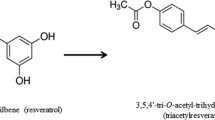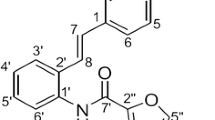Summary
Pancreatic cancer is a very aggressive malignant disease due to lack of early diagnosis and chemotherapeutic resistance of the tumor cells. There is distinct evidence that food derived polyphenols possess chemopreventive effects in the development of several cancers including pancreatic carcinoma. Resveratrol is one of those phenolic compounds found in grape skins and other fruits with known anticancer activity. Various polymethoxylated resveratrol derivatives showed stronger antiproliferative effects than resveratrol in tumor cell lines. The aim of our study was to evaluate the cytotoxic and biochemical effects of a newly synthesized polymethoxylated resveratrol analogue, N-hydroxy-N′-(3,4,5-trimethoxphenyl)-3,4,5-trimethoxy-benzamidine (KITC) in two human pancreatic cancer cell lines. The human pancreatic cancer cell lines, AsPC-1 and BxPC-3 were used to test the potential inhibitory effect of the resveratrol derivative on cell proliferation and the underlying mechanisms of this effect. After 7 days of incubation, KITC inhibited the growth of AsPC-1 and BxPC-3 cells with IC50 values of 9.6 and 8.7 μM, respectively. KITC (40 μM) arrested cells in the G0/G1 phase and depleted cells in the S phase of the cell cycle (−105% and −35% of control, respectively). KITC induced dose-dependent apoptosis in both pancreatic cancer cell lines and was found to significantly reduce the in situ activity of ribonucleotide reductase, the key enzyme of DNA synthesis. Employing growth inhibition assays, KITC acted synergistically with gemcitabine in both cell lines. In summary, we found that KITC exerted considerable antitumor activity against human pancreatic cancer cells and could be a promising candidate for further investigations to establish a new chemotherapeutic regimen.





Similar content being viewed by others
References
Blackstock AW, Cox AD, Tepper JE (1996) Treatment of pancreatic cancer: current limitations, future possibilities. Oncology (Williston Park) 10:301–307, discussion: 308–323, 1996
Raimondi S, Maisonneuve P, Löhr JM, Lowenfels AB (2007) Early onset pancreatic cancer: evidence of a major role for smoking and genetic factors. Cancer Epidemiol Biomarkers Prev 16:1894–1897 doi:10.1158/1055-9965.EPI-07-0341
Golkar L, Ding XZ, Ujiki MB, Salabat MR, Kelly DL, Scholtens D et al (2007) Resveratrol inhibits pancreatic cancer cell proliferation through transcriptional induction of macrophage inhibitory cytokine-1. Surg Res 138:163–169 doi:10.1016/j.jss.2006.05.037
DiMagno EP, Reber HA, Tempero MA (1999) AGA technical review on the epidemiology, diagnosis, and treatment of pancreatic ductal adenocarcinoma. American Gastroenterological Association. Gastroenterology 117:1464–1484 doi:10.1016/S0016-5085(99)70298-2
Norell SE, Ahlbom A, Erwald R, Jacobson G, Lindberg-Navier I, Olin R et al (1986) Diet and pancreatic cancer: a case-control study. Am J Epidemiol 124:894–902
Steinmetz KA, Potter JD (1996) Vegetables, fruit, and cancer prevention: a review. J Am Diet Assoc 96:1027–1039 doi:10.1016/S0002-8223(96)00273-8
Bravo L (1998) Polyphenols: chemistry, dietary sources, metabolism, and nutritional significance. Nutr Rev 56:317–333
Lu R, Serrero G (1999) Resveratrol, a natural product derived from grape, exhibits antiestrogenic activity and inhbits the growth of human breast cancer cells. J Cell Physiol 179:297–304 doi:10.1002/(SICI)1097-4652(199906)179:3<297::AID-JCP7>3.0.CO;2-P
Jang M, Cai L, Udeani GO, Slowing KV, Thomas CF, Beecher CW et al (1997) Cancer chemopreventive activity of resveratrol, a natural product derived from grapes. Science 275:218–220 doi:10.1126/science.275.5297.218
Schneider Y, Vincent F, Duranton B, Badolo L, Gossé F, Bergmann C et al (2000) Anti-proliferative effect of resveratrol, a natural component of grapes and wine, on human colonic cancer cells. Cancer Lett 158:85–91 doi:10.1016/S0304-3835(00)00511-5
Kampa M, Hatzoglou A, Notas G, Damianaki A, Bakogeorgou E, Gemetzi C et al (2000) Wine antioxidant polyphenols inhibit the proliferation of human prostate cancer cell lines. Nutr Cancer 37:223–233 doi:10.1207/S15327914NC372_16
Ding XZ, Adrian TE (2002) Resveratrol inhibits proliferation and induces apoptosis in human pancreatic cancer cells. Pancreas 5:71–76 doi:10.1097/00006676-200211000-00024
Clément MV, Jayshreekumari LH, Sanaul-Haq C, Pervaiz S (1998) Chemopreventive agent Resveratrol, a natural product derived from grapes, triggers CD95 signaling-dependent apoptosis in human tumor cells. Blood 92:996–1002
Dörrie J, Gerauer H, Wachter Y, Zunino SJ (2001) Resveratrol induces extensive apoptosis by depolarizing mitochondrial membranes and activating caspase-9 in acute lymphoblastic leukemia cells. Cancer Res 61:4731–4739
Sun NJ, Woo SH, Cassady JM, Snapka RM (1998) DNA polymerase and topoisomerase II inhibitors from Psorealea corylifolia. J Nat Prod 61:362–366 doi:10.1021/np970488q
Fontecave M, Lepoivre M, Elleingand E, Gerez C, Guittet O (1998) Resveratrol, a remarkable inhibitor of ribonucleotide reductase. FEBS Lett 421:277–279 doi:10.1016/S0014-5793(97)01572-X
Elford HL, Freese E, Passamani E, Morris HP (1970) Ribonucleotide reductase and cell proliferation: Variations of ribonucleotide reductase activity with tumor growth rate in a series of rat hepatomas. J Biol Chem 245:5228–5233
Takeda E, Weber G (1981) Role of ribonucleotide reductase in expression in the neoplastic program. Life Sci 28:1007–1014 doi:10.1016/0024-3205(81)90746-3
Gosslau A, Chen M, Ho CT, Chen KY (2005) A methoxy derivative of resveratrol analogue selectively induced activation of the mitochondrial apoptotic pathway in transformed fibroblasts. Br J Cancer 92:513–521
Sale S, Tunstall RG, Ruparelia KC, Potter GA, Steward WP, Gescher AJ (2005) Comparison of the effects of the chemopreventive agent resveratrol and its synthetic analog trans 3,4,5,4′-tetramethoxystilbene (DMU-212) on adenoma development in the Apc(Min+) mouse and cyclooxygenase-2 in human-derived colon cancer cells. Int J Cancer 115:194–201 doi:10.1002/ijc.20884
Schneider Y, Chabert P, Stutzmann J, Coelho D, Fougerousse A, Gosse F et al (2003) Resveratrol analog (Z)-3,5,4′-trimethoxystilbene is a potent anti-mitotic drug inhibiting tubulin polymerization. Int J Cancer 107:189–196 doi:10.1002/ijc.11344
El Zayat AA, Degen D, Drabek S, Clark GM, Pettit GR, Von Hoff DD (1993) In vitro evaluation of the antineoplastic activity of combretastatin A-4, a natural product from Combretum caffrum (arid shrub). Anticancer Drugs 4:19–25
Nabha SM, Wall NR, Mohammad RM, Pettit GR, Al Katib AM (2000) Effects of combretastatin A-4 prodrug against a panel of malignant human B-lymphoid cell lines. Anticancer Drugs 11:385–392 doi:10.1097/00001813-200006000-00009
Iyer S, Chaplin DJ, Rosenthal DS, Boulares AH, Li LY, Smulson ME (1998) Induction of apoptosis in proliferating human endothelial cells by the tumor-specific antiangiogenesis agent aombretastatin A-4. Cancer Res 58:4510–4514
McGown AT, Fox BW (1990) Differential cytotoxixity of combretastatins A1 and A4 in two daunorubicin-reistant P388 cell lines. Cancer Chemother Pharmacol 26:79–81
Chaplin DJ, Pettit GR, Hill SA (1999) Anti-vascular approaches to solid tumour therapy: evaluation of combretastatin A4 phosphate. Anticancer Res 19:189–195
Saiko P, Ozsvar-Kozma M, Bernhaus A, Jaschke M, Graser G, Lackner A et al (2007) N-hydroxy-N′-(3,4,5-trimethoxyphenyl)-3,4,5-trimethoxybenamidine, a novel resveratrol analog, inhibits ribonucleotide reductase in HL-60 human promyelocytic leukaemia cells: synergistic antitumor activity with arabinofuranosylcytosine. Int J Oncol 31:1261–1266
Handler N, Saiko P, Jaeger W, Szekeres T, Wacheck V, Berner H et al (2008) Synthesis and cytotoxic activity of resveratrol-based compounds. Chem Mon 139:575–578 doi:10.1007/s00706-007-0791-2
Szekeres T, Gharehbaghi K, Fritzer M, Woody M, Srivastava A, van’t Riet B et al (1994) Biochemical and antitumor activity of trimidox, a new inhibitor of ribonucleotide reductase. Cancer Chemother Pharmacol 34:63–66 doi:10.1007/BF00686113
Chou TC, Talalay P (1984) Quantitative analysis of does-effect relationships: the combined effect of multiple drugs or enzyme inhibitiors. Adv Enzyme Regul 22:27–55 doi:10.1016/0065-2571(84)90007-4
Elleingand E, Gerez C, Un S, Knupling M, Lu G, Salem J et al (1998) Reactivity studies of the tyrsoyl radical in ribonucleotide reductase from Mycobacterium tuberculosis and Arabidopsis thaliana – comparison with Escherichia coli and mouse. Eur J Biochem 258:485–490 doi:10.1046/j.1432-1327.1998.2580485.x
Potter GA, Patterson LH, Wanogho E, Perry PJ, Butler PC, Ijaz T et al (2002) The cancerpreventive agent resveratrol is converted to the anticancer agent piceatannol by the cytochrome P450 enzyme CYP1B1. Br J Cancer 86:774–778 doi:10.1038/sj.bjc.6600197
Ovesna Z, Kozics K, Bader Y, Saiko P, Handler N, Erker T et al (2006) Antioxidant activity of resveratrol, piceatannol and 3,3′,4,4′,5,5′-hexahydroxy-trans-stilbene in three leukemia cell lines. Oncol Rep 16:617–624
Murias M, Handler N, Erker T, Pleban K, Ecker G, Saiko P et al (2004) Resveratrol analogues as selective cyclooxygenase-2 inhibitors: synthesis and structure-activity relationship. Bioorg Med Chem 12:5571–5578 doi:10.1016/j.bmc.2004.08.008
Murias M, Jager W, Handler N, Erker T, Horvath Z, Szekeres T et al (2005) Antioxidant, prooxidant and cytotoxic activity of hydroxylated resveratrol analogues: structure-activity relationship. Biochem Pharmacol 69:903–912 doi:10.1016/j.bcp.2004.12.001
Sale S, Verschoyle RD, Boocock D, Jones DJ, Wilsher N, Ruparelia KC et al (2004) Pharmacokinetics in mice and growth-inhibitory properties of the putative cancer chemopreventive agent resveratrol and the synthetic analogue trans 3,4,5,4′-tetramethoxystilbene. Br J Cancer 90:736–744 doi:10.1038/sj.bjc.6601568
Ferreira MJ, Duarte N, Gyemant N, Radics R, Cherepnev G, Varga A et al (2006) Interaction between doxorubicin and the resistance modifier stilbene on multidrug resistant mouse lymphoma and human breast cancer cells. Anticancer Res 26:3541–3546
Chabert P, Fougerousse A, Brouillard R (2006) Anti-mitotic properties of resveratrol analog (Z).3,5,4′-trimethoxystilbene. Biofactors 27:37–46
Heinemann V (2002) Present and future treatment of pancreatic cancer. Semin Oncol 29:23–31 doi:10.1053/sonc.2002.34269
Plunkett W, Huang P, Xu YZ, Heinemann V, Grunewald R, Gandhi V (1995) Gemcitabine: metabolism, mechanisms of action, and self-potentiation. Semin Oncol 22:3–10
Author information
Authors and Affiliations
Corresponding author
Rights and permissions
About this article
Cite this article
Bernhaus, A., Ozsvar-Kozma, M., Saiko, P. et al. Antitumor effects of KITC, a new resveratrol derivative, in AsPC-1 and BxPC-3 human pancreatic carcinoma cells. Invest New Drugs 27, 393–401 (2009). https://doi.org/10.1007/s10637-008-9183-7
Received:
Accepted:
Published:
Issue Date:
DOI: https://doi.org/10.1007/s10637-008-9183-7




